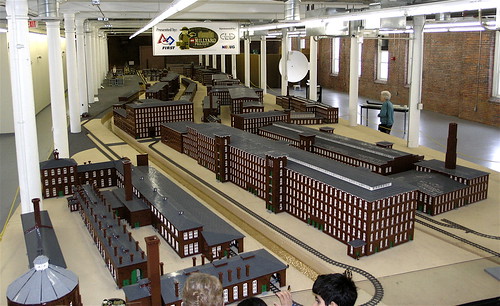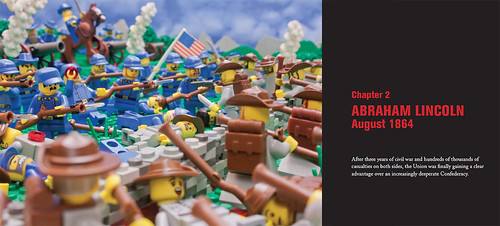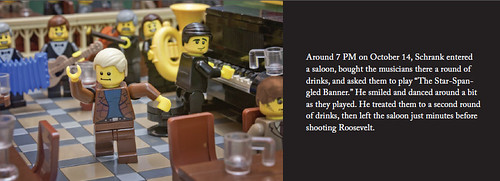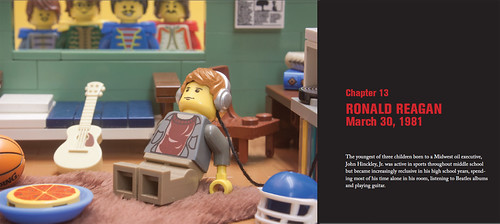I'm posting this same post across all of my blogs, btw.

Steampunk LEGO by Guy Himber
No starch press, 200 pages, 2015
Guy is certainly one of the preeminant AFOLs in the steampunk genre, and he's gathered together a collection of models by a lot of other great builders. If you don't know, steampunk is kind of the sci-fi of the Victorian era. The neat thing about this book is that rather than just being page after page of photos of LEGO models, this is put together more like a scrapbook made in the late 1800s. The pages have interesting backgrounds that look like parchment, maps, or pages out of old books. The fonts are often flowing script, or look like they were banged out on a manual typewriter. The images are 'attached' with those photo corners you might see in your granparents' photo albums. The pictures are sometimes in full color, but often in black and white or sepia tones. And the text is all by the fictional chronicler reporting back to Queen Victoria. The result is a very enjoyable volume that stands out from some of the other books that highlight great builds, but sometimes become repetitive (particularly if you have already seen them online). The audience here is probably for the older teen or adult with some interest in this genre, but really any interest in great LEGO models presented interestingly. I highly recommend this book.

LEGO Play Book by Daniel Lipkowitz
Dorling Kindserly (DK), 200 pages, 2013
This book brings together eight builders and lets each of them loose for a chapter based on a given theme. Barney Main builds fairy tales, Tim Goddard microscale, Pete Reid and Yvonne Doyle team up to make animals, and so on. Some of the chapters have a story connecting the models, and others are more collections. My son and I got this from the library when it came out (I really thought I'd reviewed it already) and we had so much fun going through it. We renewed the subscription three times because we were reading through a few pages each night at bedtime, just savoring the experience. He's 5, I'm 45, and we both thought it was great. Probably the main message was to encourage kids to be creative. If you have a kid who is in to LEGO, get them this book. You won't regret it.

LEGO Minifigure Year by Year: A Visual History by Gregory Farshtey with Daniel Lipkowitz
Dorling Kindserly (DK), 256 pages, 2013
While DK has put out a few books like the LEGO Play Book just mentioned, they are more known for putting out books that are little more than catalogs - big compendiums of all of the LEGO Star Wars sets, or all of the LEGO Harry Potter sets, or all of the LEGO Batman sets, etc. I'm generally not a fan of these. This book falls in that category. It's kind of a rehash of Standing Small, a book DK put out a few years ago focused on minifigs, or the LEGO Minifigures Character Encyclopedia, though that was exclusively on the Collectible lines. This book is unique in that, rather than grouping all of the castle figs in one place and all of the Star Wars figs in another, it goes through, well, year by year, just like the title says. So you see groups of figs in chronological order. It's not a comprehensive listing like Christoph Bartneck's Unofficial LEGO Minifigure Catalog, so it's not useful as a reference book, but it is kind of fun to page through and see the evolution of the fig from the classic smiley to today's very detailed figs. Probably the best part is the inclusion of some of the prototypes and other precursors to the modern fig. A nice coffee table book, but probably not something you'd sit down and read. An okay gift for the casually interested person, but I'd rather give them the LEGO Play Book to show them what you can do when you're being creative.

The LEGO Neighborhood Book by Brian Lyles and Jason Lyles
No starch press, 200 pages, 2014
This book focuses on building in the Cafe Corner style. The book is about 10-20% discussion of building style and sources of inspiration, about 30-40% pictures of models by the authors, and about 50% detailed building instructions to make a few large buildings and also some detail features like lampposts and benches. The models are great, and the instructions are really clear. If you like the Cafe Corner sets and want to make more of your own, this is the book for you. Definitely for older teens and adult builders, simply for the scale of the projects involved.

Brick Shakespeare: The Comedies by John McCann, Monica Sweeney, and Becky Thomas
Skyhorse Publishing, 342 pages, 2014
Okay, here's where reviewing is no fun. I absolutely hated Brick Shakespeare: The Tragedies by these authors, and I'm not much happier with this one either. This book is essentially a collection of four LEGO-illustrated plays - A Midsummer Night's Dream, The Tempest, Much Ado about Nothing, and The Taming of the Shrew. These are put together in much the same style as the Brick Bible books by Brendan Powell Smith. It's just that, well, the models and photography aren't very good. As I said when I reviewed the previous book, if this were five years ago I might feel differently, but there are so many high quality LEGO books on the market now that I just can't recommend this. I suppose if you are really into Shakespeare you might want this, but I wouldn't rush out to get it.

Brick Fairy Tales by John McCann, Monica Sweeney, and Becky Thomas
Skyhorse Publishing, 264 pages, 2014
This book has LEGO-illustrated versions of Cinderella, Rapunzel, Snow White, Hansel and Gretel, and nine other stories (some longer, some shorter), but my comments are the same as they were for the Brick Shakespeare book. Avoid this.
I should say that I really don't like writing bad reviews. I'd like these to be better, I really would. I don't have anything against the authors, except that I want them to go on line and see what is actually being built out of LEGO these days so they can strive to do better.
There are many other LEGO books I don't have that have come out in the last year, and there's no way to cover them all. Here, though, are some that look particularly interesting to me. As soon as I get them I'll write full reviews.

Beautiful LEGO 2: Dark by Mike Doyle
No starch press, 340 pages, 2014
I completely loved book 1 and am looking forward to getting book 2. In book 1 Mike was really focused on LEGO as artwork, and he brought together works by others to show just that. For this book he publicly called for people to submit or suggest artistic MOCs with a much darker theme. I've seen many of the creations that were submitted, and I look forward to seeing how they all came together in the book.

Art of the Brick by Nathan Sawaya
No starch press, 248 pages, 2014
We're all familiar with Nathan's creations, and you may have even attended one of his traveling exhibitions that have been in art museums all over the world. This book appears to be the companion piece to the exhibit.

Art of LEGO Design by Jordan Schwartz
No starch press, 288 pages, 2014
Jordan was certainly one of the most creative builders around at a very young age. He even got a chance to go to Denmark as a LEGO intern, and I believe he designed a few sets during his internship (I should probably check the details on that). He seems to have dropped out of the hobby for a few years, but he's back with this book that looks at the process of designing MOCs, including interviews with the builders of the work shown.

Revolution! by Brendan Powell Smith
Skyhorse Publishing, 2014
Okay, I'm recommending this one without ever seeing a page of it. We know Brendan from his decade-long project to illustrate the Bible, but last year he came out with Assasination!, focused on assasinations and attempted assasinations of American presidents. I wasn't only impressed by the illustrations - I expected those based on Brendan's previous work - but also by the writing, which was both informative and engaging. Anyone with any interest in history would enjoy it. So, I suppose this is a complete assumption, but I'm going to guess that Revolution!, a LEGO-illustrated history of the American Revolutionary War, will be similarly enjoyable on multiple levels.

Brick City by Warren Elsmore
Barron's, 256 pages, 2013
I've flipped through this one in the store and it looks really good. This is focused on models of well known buildings and other landmarks from around the world, such as the Empire State Building, the Eiffel Tower, etc., mostly at microscale. Perhaps my only concern is that it's a smaller book, whereas bigger pages would make some of the details easier to see. On the other hand, it's hard to carry a large coffee-table sized book with you, so this is nice too.

Brick Wonders by Warren Elsmore
Barron's, 256 pages, 2014
Again, I've looked through this one and it's on my wish list as well. Whereas Brick City was more about modern structures, this one is broader in scope, with ancient structures such as the Pyramids and Babylon, natural wonders such as the Grand Canyon, and even modern things such as the International Space Station. Again, the models look great and the photography is great as well.

Brick Flicks by Warren Elsmore
Barron's, 160 pages, 2014
This is another one that I'm listing without ever seeing it. I actually didn't know this one existed until I was getting the links for the other two by Warren. Based on the strengths of those, though, I'm looking forward to getting Brick Flicks. My only concern is that it appears to be 40% shorter than Brick City and Brick Wonders.




































